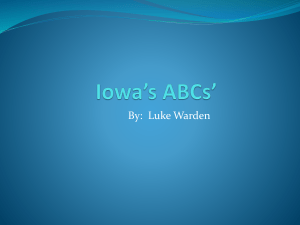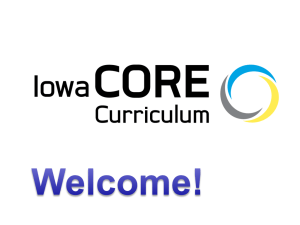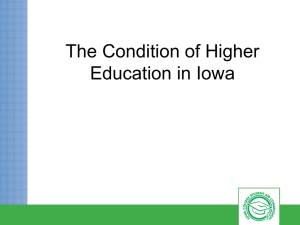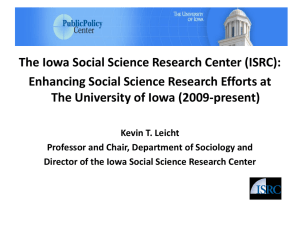powerpoint
advertisement
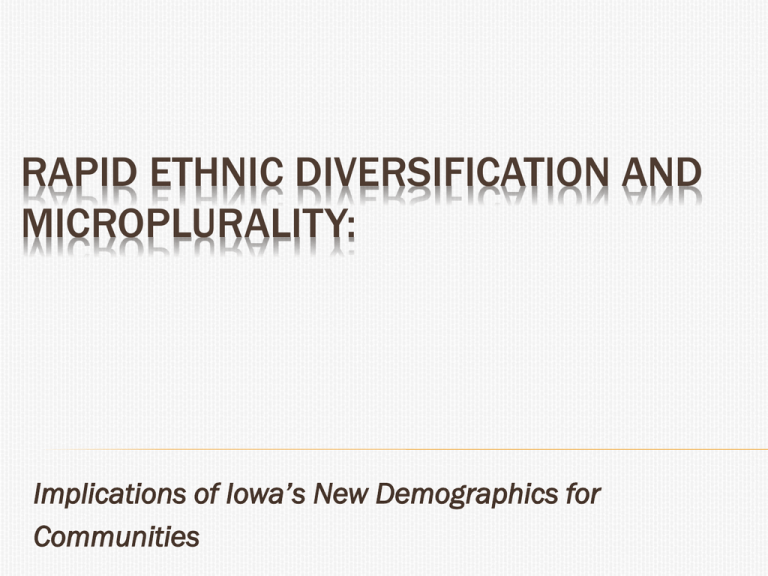
RAPID ETHNIC DIVERSIFICATION AND MICROPLURALITY: Implications of Iowa’s New Demographics for Communities PRESENTERS Dr. Mark Grey Professor and Director Iowa Center on Immigrant Leadership and Integration Dr. Michele Devlin Professor and Director Iowa Center on Health Disparities University of Northern Iowa OVERVIEW OF THE NEW DEMOGRAPHICS TWO KEY CONCEPTS Rapid Ethnic Diversification vs. “Diversity” Microplurality RAPID ETHNIC DIVERSIFICATION VS. DIVERSITY Diversity is usually based on a snapshot, or pointin-time perspective Our town is “diverse” because we have 10 Latino families We are experiencing “diversity” because we now have residents with different ethnicities RAPID ETHNIC DIVERSIFICATION VS. DIVERSITY “Valuing diversity” is often a dodge to avoid talking about difficult issues like class and politics Time to get past promoting one group’s diversity as more legitimate than another’s In the US, the term “minority” is going to apply to everyone DIVERSIFICATION We encourage health care providers (and the people who train them) to ask: Is our service population experiencing “diversity” or diversification? Diversification is a process that places diverse communities within the context of history, the economy, community goals, and labor markets MICROPLURALITY Microplurality describes growth in the number of smaller ethnically and linguistically distinct groups in communities Recognizes “Diversity within Diversity” Minimizes the relevance of racial categories in favor of ethnic populations Recognizes the central role of culture, language, religion and immigration status “THE PERFECT DEMOGRAPHIC STORM” IN IOWA An aging white population Out-migration of young white population Urbanization Low birth rates among White residents Higher birth rates among newcomers In-migration of young Latinos In-migration of several diverse populations 2009 LATINO VS. IOWA’S AGE STRUCTURE HISPANIC VS. WHITE AGES The median age for Hispanics was 23.2 years in 2009 -Much less than that of Whites (39 years in 2009) PROJECTED LATINO POPULATION* Iowa’s projected Latino population: 2020: 182,190 2030: 263,860 2040: 384,320 (11% of total) *All population projections are from Woods and Poole Economics, 2010 PROJECTED HISPANIC POPULATION GROWTH 20 18 Thousands 16 14 Marshall County 12 Crawford County 10 Buena Vista 8 Dallas 6 Black Hawk 4 2 0 2000 2010 2020 Year 2030 PROJECTED HISPANIC POPULATIONS 30 Percent of Total Population Buena Vista (Storm Lake) 25 Crawford (Dennison) Marshall (Marshalltown) 20 Louisa (Columbus Junction) Woodbury (Sioux City) 15 Muscatine (Muscatine) Franklin (Hampton) Wapello (Ottumwa) 10 Wright (Clarion) Polk (Des Moines) 5 Iowa 0 2000 2010 Year 2015 LATINOS AS PERCENT OF COUNTY POPULATION IN 2040 1. 2. 3. 4. 5. 6. 7. 8. 9. 10. Marshall (45%) Crawford (43%) Louisa (41%) Buena Vista (39%) Woodbury (36%) Muscatine (34%) Allamakee (26%) Franklin (22%) Polk (22%) Wapello (21%) 11. 12. 13. 14. 15. 16. 17. 18. 19. 20. Wright (17%) Sioux (15%) Emmet (12%) Clarke (12%) Pottawattamie (12%) Tama (11%) Washington (11%) Taylor (10%) Hancock (10%) Osceola (10%) PROJECTED AFRICAN AMERICAN POPULATION Iowa’s projected Black population: 2020: 107,790 2030: 136,110 2040: 172,770 PROJECTED ASIAN POPULATION Iowa’s projected Asian population: 2020: 71,680 2030: 92,350 2040: 115,150 GROWING SECTORS OF IOWA’S POPULATION Year of Highest Population 1900 or earlier Year of Highest Population 1950 or earlier POPULATION DENSITY: 2000 POPULATION DENSITY: 2009 MICROPLURALITY Other newcomers have arrived in Iowa: Southeast Asia (Hmong, Vietnamese, Burmese etc.) East Asia (Chinese, etc.) Former Soviet Union (Russia, Ukraine, etc.) Former Yugoslavia (Bosnia, etc.) Ultra-Orthodox Jewish (Israel and East Coast) African (Sudan, Somalia, etc.) South Pacific (Marshall Islanders, Paulau) Ukrainian Pentacostals Central and South Americans Inner City African Americans Appalachian Whites And many more equals MICROPLURALITY! Implications for Communities SPECIAL CONSIDERATIONS More likely to have many smaller ethnic groups in town, rather than just a few larger ones Greater need for diversity and cultural competency training among staff at all levels, from receptionists to directors Greater variety of languages spoken in town More budgets for interpreters May need to rely on language line, tele-interpretation, etc. More likely to see rare languages, like Dinka, Nuer, etc. Need training for interpreters and the staff that use them SPECIAL CONSIDERATIONS Increasingly likely to see low-income clients, presenting with multiple challenges and complicated issues Greater percentage of clients with legal rights to services, along with their families Increase in different perceptions, traditions, and norms regarding services and providers (public safety, health, social services, etc.) SPECIAL CONSIDERATIONS Greater need to include ethnically diverse clients in assessment, planning, implementation, evaluation, and boards Greater emphasis on recruitment and retention of staff from multiple ethnicities, but recognize diversity within diversity May need variety in service hours during non-traditional times Must be aware of different cultural taboos, traditional prohibitions, common rituals, unique holidays, etc. of clients Greater need to provide outreach services where clients live, work, play, recreate, worship, and study SPECIAL CONSIDERATIONS More likely to encounter cross-cultural differences involving ethical practices, confidentiality, legal complaints, etc. More likely to experience low-literacy barriers Likely will need longer visits for language/cultural barriers Greater need to build relationships with clients through faceto-face, human contact Must collect and track information on client’s ethnicity, ethnicity, spoken and written languages, literacy level, etc. SPECIAL CONSIDERATIONS Will need to maintain and update current demographic, cultural, and epidemiological profiles of the community Will require agencies to work together from multiple sectors in coordinated manner to serve clients (health, education, law enforcement, social services, religious groups, schools, housing authorities, interpreters, ethnic community; etc) Will need to provide orientation training and cultural competency programming for newcomers about Iowans Should involve employers of newcomers as well FINAL THOUGHTS Conclusion There is none! Learning to work effectively within rapidly changing demographic environments and meeting the needs of newcomers is an ongoing process Requires time, money, resources, leadership, patience, and involvement of many parties Ultimately can bring many opportunities and advantages to Iowan communities Thank You! Cultural Connections 107 HPC University of Northern Iowa Cedar Falls, IA 50614 www.iowahealthdisparities.org Dr. Mark Grey; 319 273-6496 Dr. Michele Devlin; 319 273-5806 Mark.grey@uni.edu Michele.devlin@uni.edu


